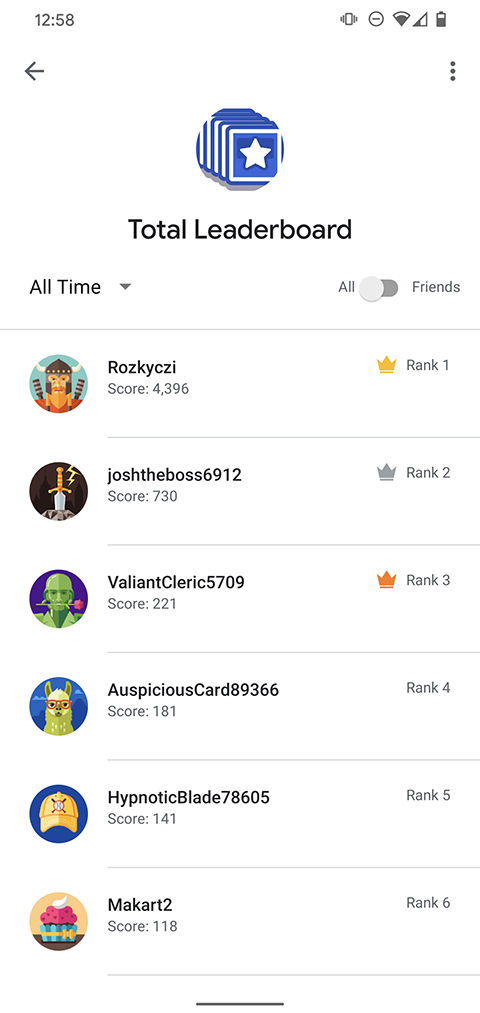پس از منسوخ شدن Google Sign-In API، ما بازیها v1 SDK را در سال 2026 حذف میکنیم. پس از فوریه 2025، نمیتوانید عناوینی را که به تازگی با بازیهای v1 SDK ادغام شدهاند، در Google Play منتشر کنید. توصیه می کنیم به جای آن از بازی ها v2 SDK استفاده کنید.
در حالی که عناوین موجود با ادغام های قبلی نسخه 1 برای چند سال به کار خود ادامه می دهند، شما تشویق می شوید که از ژوئن 2025 به نسخه 2 مهاجرت کنید .
این راهنما برای استفاده از Play Games Services v1 SDK است. برای اطلاعات در مورد آخرین نسخه SDK، به مستندات v2 مراجعه کنید.
این راهنما به شما نشان می دهد که چگونه از API های تابلوی امتیازات در یک برنامه اندروید برای ایجاد تابلوهای امتیازات بصری، ثبت امتیاز بازیکن و مقایسه امتیاز با امتیاز بازیکن در جلسات قبلی بازی استفاده کنید. APIها را میتوانید در بستههای com.google.android.gms.games و com.google.android.gms.games.leaderboards پیدا کنید.
قبل از شروع
اگر قبلاً این کار را انجام نداده اید، ممکن است مرور مفاهیم بازی تابلوهای امتیازات برای شما مفید باشد.
قبل از شروع به کدنویسی با استفاده از API های تابلوی امتیازات:
- دستورالعملهای نصب و راهاندازی برنامه خود را برای استفاده از خدمات بازیهای Google Play در راهنمای راهاندازی سرویسهای SDK Google Play دنبال کنید.
- با دنبال کردن دستورالعملهای راهنمای کنسول Google Play ، تابلوهای امتیازاتی را که میخواهید بازیتان نمایش داده یا بهروزرسانی کند، تعریف کنید.
- نمونه کدهای تابلوی امتیازات را در صفحه نمونه اندروید دانلود و بررسی کنید.
- با توصیه هایی که در چک لیست کیفیت توضیح داده شده است آشنا شوید.
مشتری تابلوهای امتیازات را دریافت کنید
برای شروع استفاده از تابلوهای API، بازی شما ابتدا باید یک شی LeaderboardsClient داشته باشد. می توانید این کار را با فراخوانی متد Games.getLeadeboardsClient() انجام دهید و فعالیت و GoogleSignInAccount را برای بازیکن فعلی ارسال کنید. برای یادگیری نحوه بازیابی اطلاعات حساب بازیکن، به ورود به سیستم در بازیهای Android مراجعه کنید.
امتیاز بازیکن را به روز کنید
وقتی امتیاز بازیکن تغییر میکند (مثلاً وقتی بازیکن بازی را تمام میکند)، بازی شما میتواند با فراخوانی LeaderboardsClient.submitScore() امتیاز خود را در تابلوی امتیازات بهروزرسانی کند، و شناسه تابلوی امتیازات و مقدار امتیاز خام را ارسال کند.
قطعه کد زیر نشان می دهد که چگونه برنامه شما می تواند امتیاز بازیکن را به روز کند:
Games.getLeaderboardsClient(this, GoogleSignIn.getLastSignedInAccount(this))
.submitScore(getString(R.string.leaderboard_id), 1337); یک تمرین خوب این است که شناسه تابلوی امتیازات را در فایل strings.xml خود تعریف کنید تا بازی شما بتواند با شناسه منبع به تابلوهای امتیازات ارجاع دهد. هنگام برقراری تماس برای بهروزرسانی و بارگیری امتیازات بازیکن، مطمئن شوید که این بهترین روشها را نیز دنبال میکنید تا از حد نصاب API خود جلوگیری کنید.
تابلوی امتیازات را نمایش دهید
برای نمایش تابلوی امتیازات، LeaderboardsClient.getLeaderboardIntent() را فراخوانی کنید تا Intent برای ایجاد رابط کاربری پیشفرض تابلوی امتیازات دریافت کنید. سپس بازی شما میتواند با فراخوانی startActivityForResult UI را نمایش دهد.
قطعه کد زیر نشان می دهد که چگونه برنامه شما می تواند امتیاز بازیکن را به روز کند. در قطعه کد، RC_LEADERBOARD_UI یک عدد صحیح دلخواه برای کد درخواست است.
private static final int RC_LEADERBOARD_UI = 9004; private void showLeaderboard() { Games.getLeaderboardsClient(this, GoogleSignIn.getLastSignedInAccount(this)) .getLeaderboardIntent(getString(R.string.leaderboard_id)) .addOnSuccessListener(new OnSuccessListener<Intent>() { @Override public void onSuccess(Intent intent) { startActivityForResult(intent, RC_LEADERBOARD_UI); } }); }
توجه داشته باشید که حتی اگر هیچ نتیجه ای برگردانده نشد، باید از startActivityForResult استفاده کنیم تا API بتواند هویت بسته فراخوانی را بدست آورد. نمونهای از رابط کاربری پیشفرض تابلوی امتیازات در زیر نشان داده شده است.


